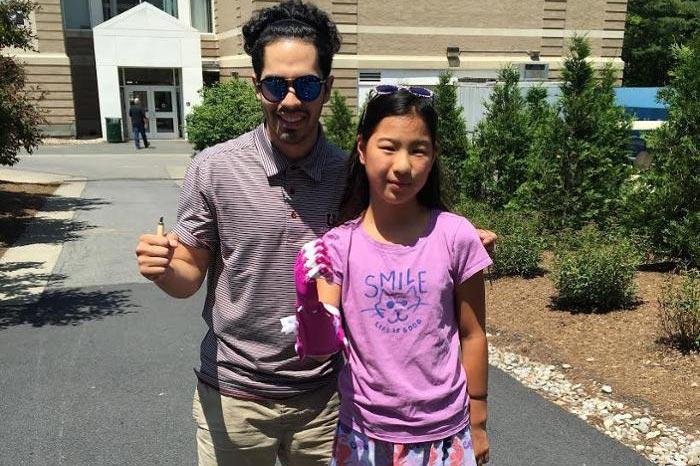For most of her young life, Myalin Schnitzer was forced to rely solely on her left arm to enjoy typical kid activities. Whether riding a bike, climbing a rock wall or flipping the pages of a book, the precocious girl had to adapt to using only her left hand.
Born in Luohe City, China, with an upper limb deficiency, Myalin is missing part of her right arm. Fitted with a conventional prosthetic when she was three, Myalin found it too unwieldy and uncomfortable. She rarely used it.
Her medical condition didn’t slow down the energetic sixth-grader with the big smile. She learned to tie her shoes, play the trumpet and participate on a competitive swim team. She even performed acrobatics at a clown camp, all singlehandedly.
When Myalin’s parents, Mark and Marie, learned about prosthetics created from a 3D printer, the family was game to give one a try.
The Schnitzers discovered that Union recently became a chapter for e-NABLE, an organization with 7,000 members in 80 countries that donates 3D-printed prosthetic hands to children around the world. Many of the families are unable to afford a conventional prosthetic, which can run as much as $3,000.
That’s when computer engineering major Diego Bazan ’18 went to work. In the final weeks of spring term, Bazan spent dozens of hours in the Collaborative Design Studio, an interdisciplinary research Makerspace in the Wold Center, to create a prosthetic limb for Myalin.
Using a design from e-NABLE, Bazan assembled the prosthetic based on measurements of the girl’s limb. Made with a corn-based plastic called polylactic acid, the prosthetic includes more than a dozen 3D-printed parts, along with fishing line and screws.
The cost for all the materials: less than $100.
The process wasn’t always smooth. Sometimes the print quality was not good. Or the fingers didn’t close all the way. But when Myalin, who turns 11 at the end of the month, had a final fitting in mid-June, she was thrilled. She returned to campus recently for a follow-up visit.
“It’s really cool,” she said, using her new fuchsia-colored hand to dig into a snack bowl of sugar snap peas held by her mom. “It makes it easier to pick up or hold things.”
Myalin picked the prosthetic’s vibrant color. If she wasn’t before, she’s now among the coolest kids at Blue Creek Elementary School in Colonie, a short ride from campus.
“My friends ask to try it on or to touch it,” she said.
After years of trying to have a child, Mark and Marie adopted Myalin from an orphanage in China when she was 18 months old. Her listing described her as precocious and always happy.
“When we met her, the bond was almost instantaneous,” said Mark. “She ate so many eggs we started to wonder if there was an amount of eggs that would be too many for a toddler to eat. A couple of days later we went to visit her orphanage and she had an eye on us the whole time to make sure we would not be leaving her behind. She was very quiet, though. A couple of days in, my wife turned her upside down by the feet and she started to laugh, and she hasn't stopped laughing and talking since.”
The couple, both engineers, is pleased with the prosthetic.
“There doesn’t seem to be an equal as far as functionality and low cost,” said Mark. “The old-style equivalent had a strap that crossed over the back and looped around the opposite shoulder and the grasper was essentially a pinching hook. They looked uncomfortable and the grasping hook looked a bit strange. The fact that this prosthetic resembles the look and function of an actual hand made Mya more interested in trying it. It is truly a work of art.”
Added Marie, “Diego did great work on this. He was very dedicated. We feel honored to be the first family to benefit from this at Union.”
Experts view 3D-printed prosthetic limbs as the next revolution in medicine, with 30 million people worldwide in need of artificial limbs and braces.
With Union named a new chapter of e-NABLE, students will have an opportunity to be a part of the wave.
“This has so much potential for an interdisciplinary approach,” said Amanda Ervin, the College’s Makerspace coordinator. “It gives students like Diego a transfer of skills. It’s one thing to make cool cellphone cases with the 3D printer. Projects like this have real-world applications.”
Bazan is back home in Revere, Mass. for the summer. When he returns to campus, he may tweak the prosthetic based on feedback from Myalin and her parents. He worked right up until the final day of spring term and in between finals, so Myalin could start using the device.
“I’m so happy for her,” he said. “She was so excited. I didn’t want her to wait.”
Myalin wants to be a veterinarian someday. In about two years, she will outgrow the prosthetic. She hopes to return to Union to be fitted with a larger one. In the meantime, she’s excited to try her new fuchsia friend for simple tasks such as a handshake.
“I really like having a hand,” she said.
